An Introduction to Scale Insects in the Landscape: What They Are, How They Live, and Management Options

Introduction to Scale Insects
Scale insects are a common plant-damaging pest found throughout the United States. Scale insects fall within the order Hemiptera. One of the distinguishing characteristics of Hemiptera is that they have piercing and sucking mouth parts. Another distinguishing feature of scale insects is that adult females are highly modified, often lacking wings, antenna, or segmentation.
Types of Scale Insects
Of the many scale insect families, only a few are considered pests in the American landscape. Most of these problem scales fall into two families: soft scales (Coccidae) and armored scales (Diaspididae).
Soft Scales:
Soft scales are physically the largest of the scale families we encounter as pests in the landscape. They can be up to ¼-inch in diameter, with magnolia scale (Neolecanium cornuparvum) being as large as ½-inch (Pellitteri 2012). The outer covering can be smooth or cottony, convex, and round to oval. Some soft scales, known as cottony scales, create distinct egg masses, which are white and cottony in appearance.
Soft scales feed within the phloem, extracting amino acids from the sap. Their excretion is a sugary substance known as honeydew. In severe infestations, honeydew can be a nuisance, causing a sticky mess on anything underneath the tree, including sidewalks, cars, and outdoor furniture. Stinging insects are attracted to honeydew, which may cause a public health risk for allergic citizens. If not removed, sooty mold fungus will begin growing on the honeydew, creating a blackened look to any affected surface and reducing the photosynthetic capacity to any affected foliage.
Armored Scales:
Armored scales are distinct from soft scales in several ways. Adult armored scales are generally smaller than soft scales, with most being less than 1/8 inch, and they are elongate to round. The tests (hard covering over the adult armored scales) of many species have an oyster shell shape, while others appear like scrambled eggs. Armored scales produce a test that is made of waxy secretions and cast skin, which is not connected to the body of the insect.
Armored scale feeding habits are also different from soft scales. Armored scales get nutrition from feeding within cells, not from sap in the phloem (Sadof and Neal 1993). Consequently, honeydew is not associated with armored scale feeding. Damage from armored scale feeding on leaves appears as a stippled chlorosis, which can eventually coalesce. Severe infestations can also cause premature leaf drop, wilting, and reduced overall vigor of the tree.
Damage and Control of Scale Insects
Small populations of scale insects rarely cause noticeable plant damage, but at high populations, these pests can cause chlorosis and early leaf drop. Severe population outbreaks can cause wilting of stems and noticeable reduction of plant vigor. Often, natural predators like lady bird beetles and parasitoid wasps control scales naturally.
Treatment Options
Accurate identification and understanding of scale insect lifecycles are vital for effective integrated pest management (IPM). Scale insects are most vulnerable as crawlers, making timing crucial. Insect growth regulators (IGRs) and horticultural oils are effective and less harmful to beneficial insects. Soil-applied imidacloprid controls soft scales but not armored scales while dinotefuran is effective against many armored scales. Utilizing a combination of practical IPM tactics can ensure that you maintain the beauty and health of your trees and plants for your park visitors.
